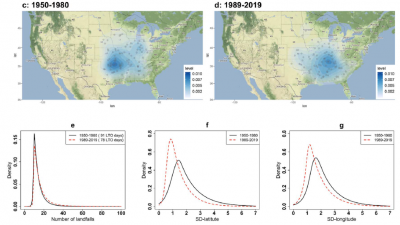Examining the Changes in the Spatial Manifestation and the Rate of Arrival of Large Tornado Outbreaks
A statistical evaluation of changes in the LTO clusters for two periods, 1950–1980 and 1989–2019, was performed. There is a geographical shift of the nucleus (central impact location) towards the southeast United States. This spatial shift is also accompanied by reduced spatial variance, suggesting LTOs have become less dispersed (or more localized) in the recent period. The overall inter-arrival rate of LTOs, and how it changed during successive 31-year climatological blocks between 1950–2019 was investigated using an exponential probability model. The arrival rate has changed from 124 days during 1950–1980 to 164 days during 1977–2007 and remained relatively constant during later periods, indicating that LTOs are becoming less frequent.
We examine large tornado outbreaks’ temporal properties, including their inter-arrival rates, seasonality, and quasi-periodic behavior. We illustrate their spatial characteristics and compare the statistics on the number of LTO days and the spatial variation between two (early and late) 31-year periods. Finally, we investigate how their return time has changed over 70 years using an exponential probability model. Understanding spatial and temporal shifts in large tornado outbreaks are of great importance, knowing that the recent Southeastward change could involve regions with a high density of mobile homes and forested terrain. The findings of this study have important implications for tornado risk management in the United States.
We investigated the (E)F2+ tornado outbreaks, called large tornado outbreaks - LTOs, which simultaneously struck several US counties in a day. Seasonality analysis of the LTO days revealed that most LTOs (69%) happened in March-April-May, and there was no record during August. Wavelet transformation of the LTO time series illustrated significant power at the decadal time scale during the 1970–1980 and a strong inter-annual cycle potentially relevant to El-Ni o Southern Oscillation. Spatial analysis of LTOs reveals that their nucleus has been shifting to the Southeast during the recent 31-years compared to the earlier records. The cluster variance has significantly decreased in both latitude and longitude direction, suggesting a decrease in spatial dispersion. Using an exponential probability model for the LTO return time, we identified the arrival rate of LTOs during 40 successive 31-year periods. Results showed that LTOs became less frequent between 1950–1980 and 1977–2007.

